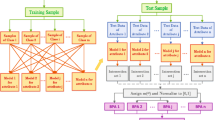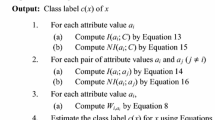Abstract
As an important tool for knowledge representation and decision-making under uncertainty, Dempster-Shafer evidence theory (D-S theory) has been used in many fields. The application of D-S theory is critically dependent on the availability of the basic probability assignment (BPA). The determination of BPA is still an open issue. A non-parametric method to obtain BPA is proposed in this paper. This method can handle multi-attribute datasets in classification problems. Each attribute value of the dataset sample is treated as a stochastic quantity. Its non-parametric probability density function (PDF) is calculated using the training data, which can be regarded as the probability model for the corresponding attribute. The BPA function is then constructed based on the relationship between the test sample and the probability models. The missing attribute values in datasets are treated as ignorance in the framework of the evidence theory. This method does not have the assumption of any particular distribution. As a result, it can be flexibly used in many engineering applications. The obtained BPA can avoid high conflict between evidence, which is desired in data fusion. Several benchmark classification problems are used to demonstrate the proposed method and to compare against existing methods. The constructed classifier based on the proposed method compares well to the state-of-the-art algorithms.






Similar content being viewed by others
Notes
UCI Machine Learning Repository: http://archive.ics.uci.edu/ml/datasets/Iris
References
Tan K C, Chen Y J, Wang L F, Liu D K (2005) Intelligent sensor fusion and learning for autonomous robot navigation. Appl Artif Intell 19(5):433–456
Li X, Dai X, Dezert J, Smarandache F (2010) Fusion of imprecise qualitative information. Appl Intell 33(3):340–351
Federico C (2013) A review of data fusion techniques. The Scientific World J 2013: Article ID 704504
Bella A, Ferri C, Hernández-Orallo J, Ramírez-Quintana M (2013) On the effect of calibration in classifier combination. Appl Intell 38(4):566–585
Lin Y, Hu X, Wu X (2014) Ensemble learning from multiple information sources via label propagation and consensus. Appl Intell doi:10.1007/s10489-013-0508-7
Dempster A P (1967) Upper and lower probabilities induced by a multivalued mapping. Ann Math Statist 38(2):325–339
Shafer G (1976) A mathematical theory of evidence. Princeton University Press, New Jersey
Hegarat-Mascle L, Bloch I, Vidal-Madjar D (1997) Application of Dempster-Shafer evidence theory to unsupervised classification in multisource remote sensing. IEEE T Geosci Remote Sens 35(4):1018–1031
Hall D L, McMullen S A (2004) Mathematical techniques in multisensor data fusion. Artech House, Massachusetts
Fenelon V, Santos P E, Dee H M, Cozman F G (2013) Reasoning about shadows in a mobile robot environment. Appl Intell 38(4):553–565
Liao S H, Chen Y J (2013) A rough set-based association rule approach implemented on exploring beverages product spectrum. Appl Intell 40(3):464–478
Alejandro Gomez S, Ivan Chesnevar C, Simari G R (2010) Reasoning with inconsistent ontologies through argumentation. Appl Artif Intell 24(1-2):102–148
Park S, Lee S R (2013) Red tides prediction system using fuzzy reasoning and the ensemble method. Appl Intell 40(2):244–255
Deng Y, Sadiq R, Jiang W, Tesfamariam S (2011) Risk analysis in a linguistic environment: a fuzzy evidential reasoning-based approach. Expert Syst Appl 38(12):15438–15446
Deng Y, Chan F T (2011) A new fuzzy dempster MCDM method and its application in supplier selection. Expert Syst Appl 38(8):9854–9861
Altincay H (2006) On the independence requirement in Dempster-Shafer theory for combining classifiers providing statistical evidence. Appl Intell 25(1):73–90
Liu W, McBryan D, Bundy A (1998) The method of assigning incidences. Appl Intell 9(2):139–161
Veremme A, Lefevre E, Morvan G, Dupont D, Jolly D (2012) Evidential calibration process of multi-agent based system: an application to forensic entomology. Expert Syst Appl 39(3):2361–2374
Dymova L, Sevastianov P, Kaczmarek K (2012) A stock trading expert system based on the rule-base evidential reasoning using level 2 quotes. Expert Syst Appl 39(8):7150–7157
Sevastianov P, Dymova L, Bartosiewicz P (2012) A framework for rule-base evidential reasoning in the interval setting applied to diagnosing type 2 diabetes. Expert Syst Appl 39(4):4190–4200
Veremme A, Lefevre E, Morvan G, Dupont D, Jolly D (2012) Evidential calibration process of multi-agent based system: an application to forensic entomology. Expert Syst Appl 39(3):2361–2374
Yager R R (1999) A class of fuzzy measures generated from a Dempster-Shafer belief structure. Int J Intell Syst 14(12):1239–1247
Zhu Y M, Bentabet L, Dupuis O, Babot D, Rombaut M (2002) Automatic determination of mass functions in Dempster-Shafer theory using fuzzy c-means and spatial neighborhood information for image segmentation. Opt Eng 41(4):760–770
Bloch I (1996) Some aspects of Dempster-Shafer evidence theory for classification of multi-modality medical images taking partial volume effect into account. Pattern Recog Lett 17(8):905–919
Salzenstein F, Boudraa AO (2001) Unsupervised multisensor data fusion approach. In: 6th international symposium on signal processing and its applications. IEEE, pp 152–155
Bendjebbour A, Delignon Y, Fouque L, Samson V, Pieczynski W (2001) Multisensor image segmentation using Dempster-Shafer fusion in Markov fields context. IEEE T Geosci Remote Sens 39(8):1789–1798
Basir O, Karray F, Zhu H (2005) Connectionist-based Dempster-Shafer evidential reasoning for data fusion. IEEE T Neural Netw 16(6):1513–1530
Wang H, Liu J, Augusto J C (2010) Mass function derivation and combination in multivariate data spaces. Inf Sci 180(6):813–819
Xu P, Deng Y, Su X, Mahadevan S (2013) A new method to determine basic probability assignment from training data. Knowl-Based Syst 46:69–80
Huang X, Zhu Q (2002) A pseudo-nearest-neighbor approach for missing data recovery on Gaussian random data sets. Pattern Recog Lett 23(13):1613–1622
Jirousek R (2010) Approximation of data by decomposable belief models. In: Information processing and management of uncertainty in knowledge-based systems. Theory and Methods. Springer, pp 40–49
Haider S (2003) On computing marginal probability intervals in inference networks. In: IEEE international conference on systems, man and cybernetics. IEEE, pp. 4724–4729
McClean S, Scotney B (1997) Using evidence theory for the integration of distributed databases. Intern J Intell Syst 12(10):763–776
Beynon MJ (2008) An Exposition of NCaRBS: Analysis of US banks and moodys bank financial strength rating. In: Soft computing applications in business, vol 230. Springer, pp 93–111
Beynon M, Page K (2010) Analysing incomplete consumer web data using the classification and ranking belief simplex (Probabilistic reasoning and evolutionary computation). In: Marketing intelligent systems using soft computing, vol 258. Springer- Berlin Heidelberg, pp. 447–473
Frank A, Asuncion A (2010) UCI machine learning repository
Hettich S, Bay S (1999) The UCI KDD archive
Sankararaman S, Mahadevan S (2011) Likelihood-based representation of epistemic uncertainty due to sparse point data and/or interval data. Reliab Eng Syst Saf 96(7):814–824
Huang S, Su X, Hu Y, Mahadevan S, Deng Y (2014) A new decision-making method by incomplete preferences based on evidence distance. Knowl-Based Syst 56:264–272
Deng X, Hu Y, Deng Y, Mahadevan S (2014) Supplier selection using AHP methodology extended by d numbers. Expert Syst Appl 41(1):156–167
Browne F, Rooney N, Liu W, Bell D, Wang H, Taylor P S, Jin Y (2013) Integrating textual analysis and evidential reasoning for decision making in engineering design. Knowl-Based Syst 52:165–175
Zhang Y, Deng X, Wei D, Deng Y (2012) Assessment of e-commerce security using AHP and evidential reasoning. Expert Syst Appl 39(3):3611–3623
Deng X, Hu Y, Deng Y, Mahadevan S (2014) Environmental impact assessment based on d numbers. Expert Syst Appl 41(2):635–643
Liu Z, Pan Q, Dezert J (2013) Evidential classifier for imprecise data based on belief functions. Knowl-Based Syst 52:246–257
Tian J, Yu B, Yu D, Ma S (2014) Missing data analyses: a hybrid multiple imputation algorithm using gray system theory and entropy based on clustering. Appl Intell 40(2):376–388
Liu Z, Pan Q, Dezert J, Mercier G (2014) Credal classification rule for uncertain data based on belief functions. Pattern Recog 47:2532–2541
Liu Z, Pan Q, Dezert J (2014) A belief classification rule for imprecise data. Appl Intell 40(2):214–228
Deng Y, Jiang W, Sadiq R (2011) Modeling contaminant intrusion in water distribution networks: a new similarity-based DST method. Expert Syst Appl 38(1):571–578
Wei D, Deng X, Zhang X, Deng Y, Mahadevan S (2013) Identifying influential nodes in weighted networks based on evidence theory. Physica A 392(10):2564–2575
Durante F, Fernandez Sanchez J, Trutschnig W (2013) On the interrelation between Dempster-Shafer belief structures and their belief cumulative distribution functions. Knowl-Based Syst 52:107–113
Abedinzadeh S, Sadaoui S (2014) A trust-based service suggestion system using human plausible reasoning. Appl Intell
Kim Y, Ahmad M A (2012) Trust, distrust and lack of confidence of users in online social media-sharing communities. Knowl-Based Syst 37:438–450
Kang B, Deng Y, Sadiq R, Mahadevan S (2012) Evidential cognitive maps. Knowl-Based Syst 35:77–86
Yager R R (1987) On the Dempster-Shafer framework and new combination rules. Inf Sci 41(2):93–137
Murphy C K (2000) Combining belief functions when evidence conflicts. Decis Support Syst 29(1):1–9
Smets P (2007) Analyzing the combination of conflicting belief functions. Inf Fusion 8(4):387–412
Denoux T (2008) Conjunctive and disjunctive combination of belief functions induced by nondistinct bodies of evidence. Artif Intell 172(2):234–264
Smets P, Kennes R (1994) The transferable belief model. Artif Intell 66(2):191–234
Williams CK (1998) Prediction with Gaussian processes: fromlinear regression to linear prediction and beyond. In: Learning in graphical models. Springer, pp 599–621
Rasmussen CE. (2004) Gaussian processes for machine learning. In: Advanced lectures on machine learning. Springer, pp 63–71
Hombal V, Mahadevan S (2011) Bias minimization in Gaussian process surrogate modeling for uncertainty quantification. Intern J Uncertain Quantif 1(4):321–349
MacKay D J (1998) Introduction to Gaussian processes. NATO ASI Ser F Comput Syst Sci 168:133–166
Sacks J, Welch W J, Mitchell T J, Wynn H P (1989) Design and analysis of computer experiments. Stat Sci 4(4):409–423
Sankararaman S (2012) Uncertainty quantification and integration in engineering systems. Vanderbilt University, PhDdissertation
Rasmussen CE (2006) Gaussian processes for machine learning. MIT Press
Bowman A W, Azzalini A (1997) Applied smoothing techniques for data analysis. The kernel approach with S-Plus illustrations. Oxford University Press
Holland JH (1975) Adaptation in natural and artificial systems: an introductory analysis with applications to biology, control, and artificial intelligence. MIT Press
Fisher R A (1936) The use of multiple measurements in taxonomic problems. Ann Eugen 7(2):179–188
Witten I H, Frank E (2005) Data mining: practical machine learning tools and techniques. Morgan Kaufmann, San Francisco
Wu X, Kumar V, Quinlan J R, Ghosh J, Yang Q, Motoda H, McLachlan G J, Ng A, Liu B, Philip S Y (2008) Top 10 algorithms in data mining. Knowl Inf Syst 14(1):1–37
Acknowledgments
The author greatly appreciate the reviews’ suggestions. The work is partially supported by National Natural Science Foundation of China (Grant No. 61174022), Specialized Research Fund for the Doctoral Program of Higher Education (Grant No. 20131102130002), National High Technology Research and Development Program of China (863 Program) (Grant No. 2013AA013801), the open funding project of State Key Laboratory of Virtual Reality Technology and Systems, Beihang University (Grant No. BUAA-VR-14KF-02),General Motors R & D (Project No. ND0044200) and Joint PhD Student Scholarship of SJTU. The support is gratefully acknowledged.
Author information
Authors and Affiliations
Corresponding author
Rights and permissions
About this article
Cite this article
Xu, P., Su, X., Mahadevan, S. et al. A non-parametric method to determine basic probability assignment for classification problems. Appl Intell 41, 681–693 (2014). https://doi.org/10.1007/s10489-014-0546-9
Published:
Issue Date:
DOI: https://doi.org/10.1007/s10489-014-0546-9




